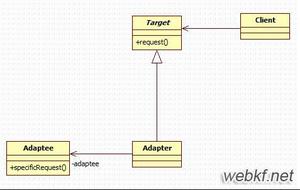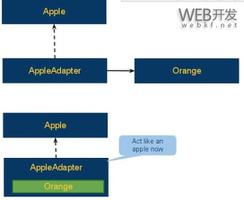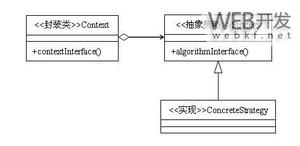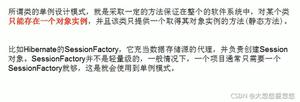C#设计模式编程中运用适配器模式结构实战演练
在实际的软件系统设计和开发中,为了完成某项工作需要购买一个第三方的库来加快开发。这带来一个问题,在应用程序中已经设计好的功能接口,与这个第三方提供的接口不一致。为了使得这些接口不兼容的类可以在一起工作,适配器模式提供了一种接口的适配机制。
适配器模式的设计思想在生活中经常会应用到,如我们在给手机充电的时候,不可能直接在220V电源上直接充电,而是用手机充电器转换成手机需要的电压才可以正常充电,否则就不可以完成充电,这个充电器就起到了适配的作用。
适配器模式结构实现
1.类适配器结构实现
ITarget.cs:
using System;
using System.Collections.Generic;
using System.Linq;
using System.Text;
namespace DesignPatterns.AdapterPattern.Structural.ClassAdapter
{
public interface ITarget
{
void Request();
}
} Adaptee.cs:
using System;
using System.Collections.Generic;
using System.Linq;
using System.Text;
namespace DesignPatterns.AdapterPattern.Structural.ClassAdapter
{
public class Adaptee
{
public void SpecificRequest()
{
Console.WriteLine("Called SpecificRequest()");
}
}
} Adapter.cs:
using System;
using System.Collections.Generic;
using System.Linq;
using System.Text;
namespace DesignPatterns.AdapterPattern.Structural.ClassAdapter
{
public class Adapter : Adaptee, ITarget
{
public void Request()
{
this.SpecificRequest();
}
}
} Client.cs:
using System;
using System.Collections.Generic;
using System.Linq;
using System.Text;
namespace DesignPatterns.AdapterPattern.Structural.ClassAdapter
{
public class Client
{
static void Main(string[] args)
{
ITarget t = new Adapter();
t.Request();
}
}
}
运行输出:
Called SpecificRequest()
请按任意键继续. . .
2.对象适配器结构实现
Client需要调用Request方法,而Adaptee并没有该方法,为了使Client能够使用Adaptee类,需要提供一个类Adapter。这个类包含了一个Adaptee的实例,将Client与Adaptee衔接起来。
ITarget.cs:
using System;
using System.Collections.Generic;
using System.Linq;
using System.Text;
namespace DesignPatterns.AdapterPattern.Structural.ObjectAdapter
{
public interface ITarget
{
void Request();
}
}
Target.cs:
using System;
using System.Collections.Generic;
using System.Linq;
using System.Text;
namespace DesignPatterns.AdapterPattern.Structural.ObjectAdapter
{
public class Target : ITarget
{
public virtual void Request()
{
Console.WriteLine("Called Target Request()");
}
}
}
Adaptee.cs:
using System;
using System.Collections.Generic;
using System.Linq;
using System.Text;
namespace DesignPatterns.AdapterPattern.Structural.ObjectAdapter
{
public class Adaptee
{
public void SpecificRequest()
{
Console.WriteLine("Called SpecificRequest()");
}
}
}
Adapter.cs:
using System;
using System.Collections.Generic;
using System.Linq;
using System.Text;
namespace DesignPatterns.AdapterPattern.Structural.ObjectAdapter
{
public class Adapter : Target
{
private Adaptee _adaptee = new Adaptee();
public override void Request()
{
_adaptee.SpecificRequest();
}
}
}
Client.cs:
using System;
using System.Collections.Generic;
using System.Linq;
using System.Text;
namespace DesignPatterns.AdapterPattern.Structural.ObjectAdapter
{
public class Client
{
static void Main(string[] args)
{
ITarget t = new Adapter();
t.Request();
}
}
}
适配器模式实践应用
以手机充电的电源适配器为例,用适配器模式的解决方案。
1.类适配器结构实现
ITarget.cs
using System;
using System.Collections.Generic;
using System.Linq;
using System.Text;
namespace DesignPatterns.AdapterPattern.Practical.ClassAdapter
{
public interface ITarget
{
void GetPower();
}
} Power.cs
using System;
using System.Collections.Generic;
using System.Linq;
using System.Text;
namespace DesignPatterns.AdapterPattern.Practical.ClassAdapter
{
public class Power
{
public void GetPower220V()
{
Console.WriteLine("从电源中得到220V的电压");
}
}
} Adapter.cs
using System;
using System.Collections.Generic;
using System.Linq;
using System.Text;
namespace DesignPatterns.AdapterPattern.Practical.ClassAdapter
{
public class Adapter : Power, ITarget
{
public void GetPower()
{
this.GetPower220V();
Console.WriteLine("得到手机的充电电压!");
}
}
} Client.cs
using System;
using System.Collections.Generic;
using System.Linq;
using System.Text;
namespace DesignPatterns.AdapterPattern.Practical.ClassAdapter
{
public class Client
{
static void Main(string[] args)
{
Console.WriteLine("手机:");
ITarget t = new Adapter();
t.GetPower();
}
}
}
运行输出:
手机:
从电源中得到220V的电压
得到手机的充电电压!
请按任意键继续. . .
2.对象适配器结构实现
ITarget.cs
using System;
using System.Collections.Generic;
using System.Linq;
using System.Text;
namespace DesignPatterns.AdapterPattern.Practical.ObjectAdapter
{
public interface ITarget
{
void GetPower();
}
}
Power.cs
using System;
using System.Collections.Generic;
using System.Linq;
using System.Text;
namespace DesignPatterns.AdapterPattern.Practical.ObjectAdapter
{
public class Power
{
public void GetPower220V()
{
Console.WriteLine("从电源中得到220V的电压");
}
}
}
Adapter.cs
using System;
using System.Collections.Generic;
using System.Linq;
using System.Text;
namespace DesignPatterns.AdapterPattern.Practical.ObjectAdapter
{
public class Adapter : ITarget
{
public Power _power;
public Adapter(Power power)
{
this._power = power;
}
/// <summary>
/// 得到想要的电压
/// </summary>
public void GetPower()
{
_power.GetPower220V();
Console.WriteLine("得到手机的充电电压!");
}
}
}
Client.cs
using System;
using System.Collections.Generic;
using System.Linq;
using System.Text;
namespace DesignPatterns.AdapterPattern.Practical.ObjectAdapter
{
public class Client
{
static void Main(string[] args)
{
Console.WriteLine("手机:");
ITarget t = new Adapter(new Power());
t.GetPower();
}
}
}
适配器模式的优缺点
在引言部分已经提出,适配器模式用来解决现有对象与客户端期待接口不一致的问题,下面详细总结下适配器两种形式的优缺点。
1.类的适配器模式:
优点:
可以在不修改原有代码的基础上来复用现有类,很好地符合 “开闭原则”
可以重新定义Adaptee(被适配的类)的部分行为,因为在类适配器模式中,Adapter是Adaptee的子类
仅仅引入一个对象,并不需要额外的字段来引用Adaptee实例(这个即是优点也是缺点)。
缺点:
用一个具体的Adapter类对Adaptee和Target进行匹配,当如果想要匹配一个类以及所有它的子类时,类的适配器模式就不能胜任了。因为类的适配器模式中没有引入Adaptee的实例,光调用this.SpecificRequest方法并不能去调用它对应子类的SpecificRequest方法。
采用了 “多继承”的实现方式,带来了不良的高耦合。
2.对象的适配器模式
优点:
可以在不修改原有代码的基础上来复用现有类,很好地符合 “开闭原则”(这点是两种实现方式都具有的)
采用 “对象组合”的方式,更符合松耦合。
缺点:
使得重定义Adaptee的行为较困难,这就需要生成Adaptee的子类并且使得Adapter引用这个子类而不是引用Adaptee本身。
使用场景
在以下情况下可以考虑使用适配器模式:
系统需要复用现有类,而该类的接口不符合系统的需求
想要建立一个可重复使用的类,用于与一些彼此之间没有太大关联的一些类,包括一些可能在将来引进的类一起工作。
对于对象适配器模式,在设计里需要改变多个已有子类的接口,如果使用类的适配器模式,就要针对每一个子类做一个适配器,而这不太实际。
.NET中适配器模式的实现
1.适配器模式在.NET Framework中的一个最大的应用就是COM Interop。COM Interop就好像是COM和.NET之间的一座桥梁(关于COM互操作更多内容可以参考我的互操作系列)。COM组件对象与.NET类对象是完全不同的,但为了使.NET程序像使用.NET对象一样使用COM组件,微软在处理方式上采用了Adapter模式,对COM对象进行包装,这个包装类就是RCW(Runtime Callable Wrapper)。RCW实际上是runtime生成的一个.NET类,它包装了COM组件的方法,并内部实现对COM组件的调用。如下图所示:
2..NET中的另外一个适配器模式的应用就是DataAdapter。ADO.NET为统一的数据访问提供了多个接口和基类,其中最重要的接口之一是IdataAdapter。DataAdpter起到了数据库到DataSet桥接器的作用,使应用程序的数据操作统一到DataSet上,而与具体的数据库类型无关。甚至可以针对特殊的数据源编制自己的DataAdpter,从而使我们的应用程序与这些特殊的数据源相兼容。
以上是 C#设计模式编程中运用适配器模式结构实战演练 的全部内容, 来源链接: utcz.com/z/325598.html








